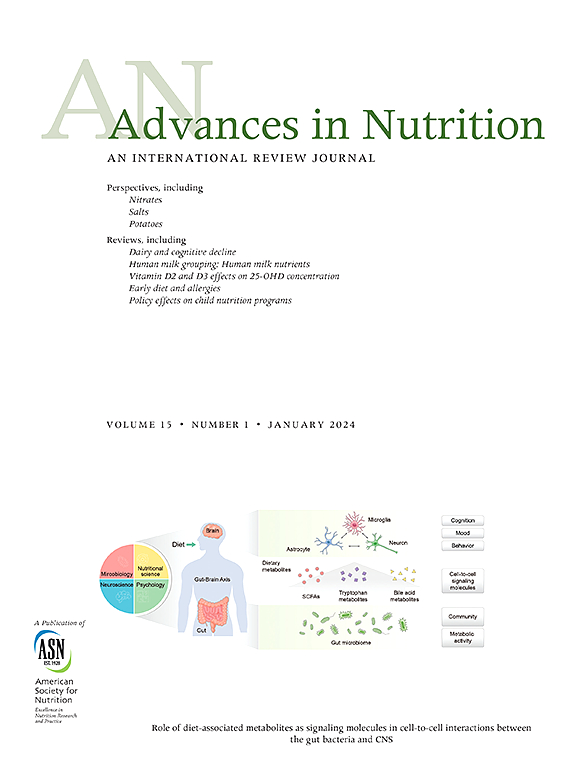Systemic Availability of Human Milk Oligosaccharides in Infants and Adults: A Narrative Review
IF 9.2
1区 医学
Q1 NUTRITION & DIETETICS
引用次数: 0
Abstract
Human milk contains many components with physiological effects beyond basic nutrition, including large quantities of structurally diverse oligosaccharides. Human milk oligosaccharides (HMOs) have been linked to health outcomes through microbiome-dependent and microbiome-independent mechanisms. To investigate the microbiome-independent effects of individual HMOs and their role in human health, it is necessary to understand their systemic availability. This narrative review focuses on the systemic availability of HMOs and summarizes studies that investigated the presence of HMOs in blood and urine following oral intake in humans. We searched PubMed using the following terms individually or in combination: human milk oligosaccharides, HMO, 2′-fucosyllactose, 3-fucosyllactose, 3′-sialyllactose, 6′-sialyllactose, difucosyllactose, lacto-N-tetraose, and lacto-N-neotetraose. The inclusion criteria were as follows: 1) study design observational or interventional; 2) cohort included breastfed infants, HMO–formula-fed infants or individuals taking HMO supplements; and 3) methods defined HMO absorption/excretion and described analysis. We identified 15 human studies. They varied in design, populations (healthy infants, infants with medical indications, and adults), administration (breastfeeding, formula, and supplement), ingested dose, sampling time points, and analytical methods. HMOs were absorbed into the bloodstream and excreted in urine, as they were detected in the blood and urine of breastfed infants, infants receiving HMO–fortified formula, and adults receiving HMO supplements, demonstrating their systemic availability. Most orally ingested HMOs appeared in blood, but some structures were not absorbed. Studies also reported that blood and urine concentrations of HMOs correlated with increasing doses. Some studies showed a difference between the number of HMOs ingested and the number of oligosaccharides found in urine. Current evidence supports the systemic availability of HMOs in both infants and adults, but absorption kinetics, rates, mechanisms, and metabolic fate remain unknown. Further research investigating the systemic availability of HMOs is needed to improve our understanding of the microbiome-independent effects of HMOs on human health.
人乳低聚糖在婴儿和成人中的全身可得性:一项叙述性综述。
母乳中含有许多具有基本营养以外的生理作用的成分,包括大量结构多样的低聚糖。人乳寡糖(HMOs)通过微生物依赖和不依赖的机制与健康结果相关。为了研究单个hmo的微生物组独立效应及其在人类健康中的作用,有必要了解它们的全身可用性。这篇叙述性综述侧重于HMOs的系统可用性,并总结了调查人类口服HMOs后血液和尿液中HMOs存在的研究。我们使用以下术语单独或组合检索PubMed:人乳寡糖,HMO, 2'- focusyllactose, 3- focusyllactose, 3'-sialyllactose, 6'-sialyllactose, di focusyllactose,乳酸-n -四糖和乳酸-n -neotetraose。纳入标准为:(1)研究设计为观察性或干预性;(2)队列包括母乳喂养的婴儿、HMO配方奶粉喂养的婴儿或服用HMO补充剂的个人;(3)定义HMO吸收/排泄和描述分析的方法。我们确定了15项人体研究。它们在设计、人群(健康婴儿、有医学指征的婴儿、成年人)、给药(母乳喂养、配方奶粉、补充剂)、摄入剂量、采样时间点和分析方法等方面各不相同。在母乳喂养的婴儿、接受HMO强化配方奶粉的婴儿和接受HMO补充剂的成年人的血液和尿液中检测到HMO被吸收到血液中并随尿液排出,证明了它们的全身可用性。大多数口服的HMOs出现在血液中,但有些结构不被吸收。研究还报告,血液和尿液中HMOs的浓度与剂量增加有关。一些研究表明,摄入的HMOs数量与尿液中发现的低聚糖数量之间存在差异。目前的证据支持HMOs在婴儿和成人的全身可用性,但吸收动力学,速率,机制和代谢命运仍然未知。需要进一步研究HMOs的系统可用性,以提高我们对HMOs对人类健康的微生物组无关效应的理解。临床试验注册编号和获取的网站:(不适用)系统评价或荟萃分析的注册编号:(不适用)显著性声明:这篇对近期研究的综述证实,婴儿和成人口服的人乳寡糖(HMOs)可以被吸收到血液中并通过尿液排出,这表明了HMOs的全身可利用性,并支持了HMOs的生理益处可能不限于其益生元模式的作用,也可能是由于其全身可利用性和作用的假设。关于HMOs的吸收机制、吸收动力学、结构特异性差异和代谢命运的关键问题仍然存在,这些见解对于促进我们对HMOs作为具有系统相关性的生物活性成分的理解至关重要。
本文章由计算机程序翻译,如有差异,请以英文原文为准。
求助全文
约1分钟内获得全文
求助全文
来源期刊

Advances in Nutrition
医学-营养学
CiteScore
17.40
自引率
2.20%
发文量
117
审稿时长
56 days
期刊介绍:
Advances in Nutrition (AN/Adv Nutr) publishes focused reviews on pivotal findings and recent research across all domains relevant to nutritional scientists and biomedical researchers. This encompasses nutrition-related research spanning biochemical, molecular, and genetic studies using experimental animal models, domestic animals, and human subjects. The journal also emphasizes clinical nutrition, epidemiology and public health, and nutrition education. Review articles concentrate on recent progress rather than broad historical developments.
In addition to review articles, AN includes Perspectives, Letters to the Editor, and supplements. Supplement proposals require pre-approval by the editor before submission. The journal features reports and position papers from the American Society for Nutrition, summaries of major government and foundation reports, and Nutrient Information briefs providing crucial details about dietary requirements, food sources, deficiencies, and other essential nutrient information. All submissions with scientific content undergo peer review by the Editors or their designees prior to acceptance for publication.
 求助内容:
求助内容: 应助结果提醒方式:
应助结果提醒方式:


